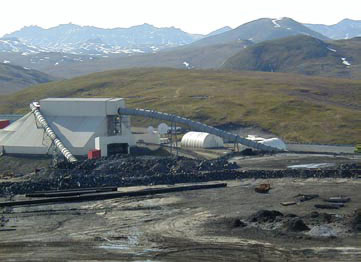 DEC puts it into perspective for Alaska May 11, 2005
"Alaskans need to understand what this really means in terms of what's actually been discharged into the air, land and water," said Environmental Conservation Commissioner Kurt Fredriksson. Chemical wholesalers, electric utilities, federal facilities such as air force bases, dairies, seafood processors, metal mines, oil refineries and petroleum bulk terminals with ten or more employees are all required to submit reports on the amount of more than 650 chemicals their facilities released into the environment (either routinely or accidentally), or otherwise managed as waste. In Alaska the mining industry produces these materials as a natural part of waste rock. "The total pounds of 'releases' do not at all reflect an accurate picture of Alaska's environmental quality. The waste rock from Alaska mines is well engineered, contained and regulated by state and federal agencies," Fredriksson added. "Alaska's TRI releases are permitted discharges, regulated under state and federal laws. Alaska's environment continues to be clean, healthy and productive." DEC prepared a guide to TRI for Alaskans, available online at www.dec.state.ak.us, which explains mining waste rock as being the reason Alaska's numbers are larger than other states. It also explains why releases in remote bush locations are greater than Alaska's more populated areas. EPA's Region 10 TRI Coordinator, Christina Colt, said that in determining risk, site-specific information is necessary, including a material's toxicity, persistence in the environment, and amount and duration of human or environmental exposure. "TRI data alone cannot be used to quantify risk to public health and the environment," Colt said. Alaska had the fewest facilities reporting releases. Alaska's most populated and industrialized Southcentral region, Anchorage and Kenai Peninsula, had a much smaller volume of releases (3.1 million pounds) than did the least populated area of the state in the Northwest Arctic region (487.37 million pounds). "Alaska has very stringent water quality standards designed to protect public health and the environment. We ensure those standards are met by minimizing any discharges and ensuring adequate treatment of all wastes to prevent pollutants from impacting downstream users," said Technical Engineer Pete McGee. More than 90% of the total
pounds reported in 2003 were primarily waste rock containing
minute levels of minerals like zinc and lead that are listed
as TRI chemicals. Waste rock from the largest zinc mine in the
world, Tech-Cominco's Red Dog Mine near Kotzebue, was the largest
reported "release" in Alaska. On the Web: Download: Source of News:
|
||
